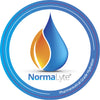How Much Salt Should I Be Eating?

How Much Salt Should I Be Eating?

That’s not an easy question to answer. Each person needs a different amount of sodium in their diet based on their unique health conditions. We always recommend talking to your doctor before starting NormaLyte. There’s lots of factors daily that can determine what is best for your daily intake as well.
- Exercise
- Mowing the grass
- Being outside in the heat
- Being over the age of 80
- Excessive sweating
- Acute illnesses (such as colds, covid, and other viruses)
The CDC says that the average person should be consuming no more than 2,300mg of sodium a day. However, if you’re someone who suffers from Postural Orthostatic Tachycardia Syndrome, or POTS, then you intimately know salt.
Dysautonomia is defined as a dysfunction of the autonomic nervous system, and POTS, is a medical condition under the dysautonomia umbrella. It causes a myriad of symptoms; fatigue, rapid heart rate, chest pain, trouble focusing, and more. Doctors have not found a cause of POTS, but they have found a way to manage it.
Managing POTS With Salt
If you have POTS you need to eat more salt! Like, way more salt than what is recommended to the average person. There’s a good reason for that.
People with POTS usually also have something called hypovolemia. Hypovolemia is a condition where your body loses fluids (like water or blood) and those fluids are an important part of ensuring your organs are performing properly. Symptoms of hypovolemia include weakness, fatigue, and dizziness. Interestingly enough, those are some of the same symptoms of POTS.
It’s important to note that hypovolemia can also be caused by vomiting, diarrhea, or other acute illnesses. It’s possible every person has experienced the symptoms of hypovolemia at some point. But if you have POTS you’re likely chronically dehydrated.
How Much Salt is Needed to Manage POTS?
Increasing your fluid and electrolyte intake with POTS is important. Especially if you’re someone who experiences blood pooling in your extremities. But how much is recommended for a person with POTS?
The Cleveland Clinic recommends between 3,000mg - 10,000mg of sodium along with a minimum of 2 liters of water a day.
This amount of sodium will help maintain your symptoms of POTS. In fact, NormaLyte was used in a clinical study and found to reduce the symptoms of POTS more effectively than IV hydration. Read more about that study here.
Is There a Difference Between Salt and Sodium?
Now, be aware that salt and sodium are not the same thing. Salt refers to the crystal like chemical compound sodium chloride. Sodium refers to the dietary mineral found in salt (or, sodium chloride).
If you were diagnosed with POTS, your doctor may have said to increase your salt intake by a certain amount. Or, they may have said to increase your sodium intake by a certain amount. Be aware that the measurements are not the same. 10,000mg of sodium is equal to 25g of salt. If the Cleveland Clinic recommends 3,000mg - 10,000mg of sodium daily then they’re also saying you should take 7.5g - 25g of salt.
If you’re looking back at the notes that your doctor sent you home with and you’re a little confused, no worries. Check this sodium calculator here to determine what the amount is for you.
Overall Takeaway
If you’re someone who suffers from a chronic illness such as POTS or maybe you’re just outside mowing the grass all summer… you may find yourself needing to supplement with an electrolyte powder like NormaLyte. Be sure to discuss with your doctor what might be right for you.







Leave a comment